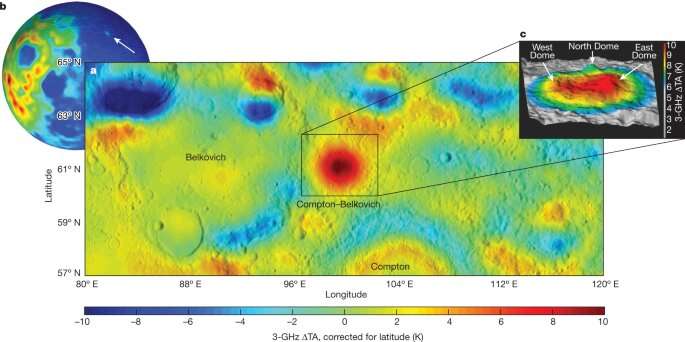Evidence of new volcanic process on moon discovered

A new instrument type has discovered evidence of a volcanic process on the moon that had only been seen on Earth.
"Before the 1950's, most scientists thought the craters on the moon were from volcanoes, then, studies associated with the Apollo missions showed that they were nearly all from impacts," said Matthew Siegler, Senior Scientist at the Planetary Science Institute and author of "Remote Detection of a Lunar Granitic Batholith at Compton-Belkovich" that appears in Nature. PSI'S Jianqing Fang is a co-lead author, and PSI funded students Katelyn Lehman and Mackenzie White are co-authors.
"There was plentiful volcanism, with flood basalts, thin flowing lavas, covering about 16% of the moon, but not much in the way of thicker, silicic lavas that could form something that we would call a volcano," Siegler said.
"Using an instrument looking at microwave wavelengths—longer than infrared—sent to the moon on both the Chinese Chang'E 1 and 2 orbiters, we have been able to map temperatures below the surface. What we found was that one of these suspected volcanoes, known as Compton-Belkovich, was absolutely glowing at microwave wavelengths," Siegler said.
"What this means is that it is hot, not necessarily at the surface, as you would see in infrared, but under the surface. The only way to explain this is from extra heat coming from somewhere below the feature within the deeper lunar crust. So Compton-Belkovich, thought to be a volcano, is also hiding a large heat source below it."
Surface evidence shows this volcano likely last erupted 3.5 billion years ago so the heat is not from molten lava or anything of that sort, but instead comes from the radioactive elements in the now solid rock. The only type of rock that really contains enough of those radioactive elements is granite. So the data collected with a fundamentally new type of microwave instrument shows that a large volcano on the moon was once fed by a much larger granite magma chamber below it—the most Earth-like volcanism on the moon.
A granitic batholith is a huge body larger than 20 kilometers of what was once subsurface lava that never erupted. Batholiths lie below volcanic chains, like the Andes or the Cascade mountain ranges, and are basically the plumbing system that feeds them. When these plumbing systems cool, they form granite. Granites, nearly absent in the Solar System outside of Earth, are a type of rock that is basically cooled-off lava that never made it to the surface.
"It was a neat project in that China made their data public—as does NASA– and we were able to work with this unique data set to figure out something really interesting about the moon. Following the rules, we could not collaborate with Chinese researchers directly and all funding came only from NASA, so we had to follow the breadcrumbs to crack this dataset open" Siegler said.
"Jianqing's ability to come to the U.S. through the J visa system to navigate the data and existing literature on the topic was very valuable. It is a great example of what can be done if science and politics can work together."
More information:
Matthew Siegler, Remote detection of a lunar granitic batholith at Compton–Belkovich, Nature (2023). DOI: 10.1038/s41586-023-06183-5. www.nature.com/articles/s41586-023-06183-5
Provided by Planetary Science Institute